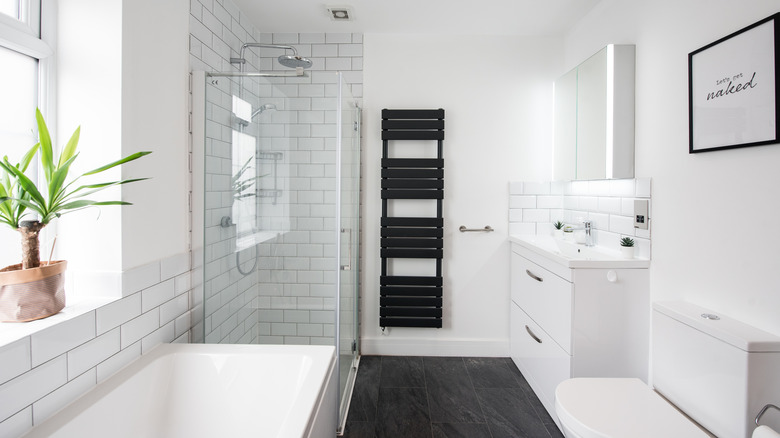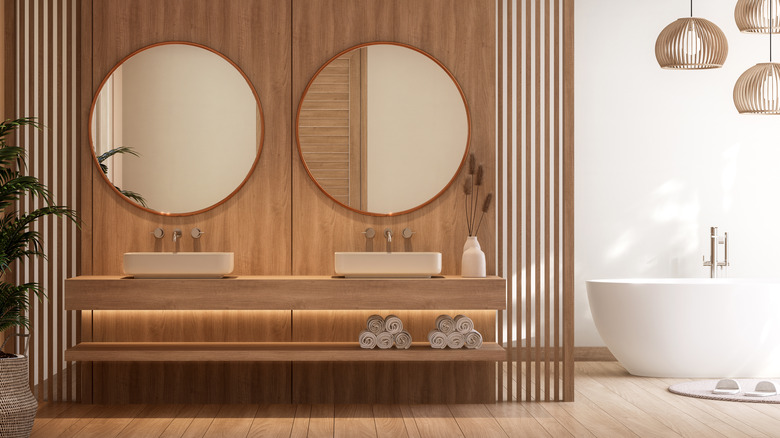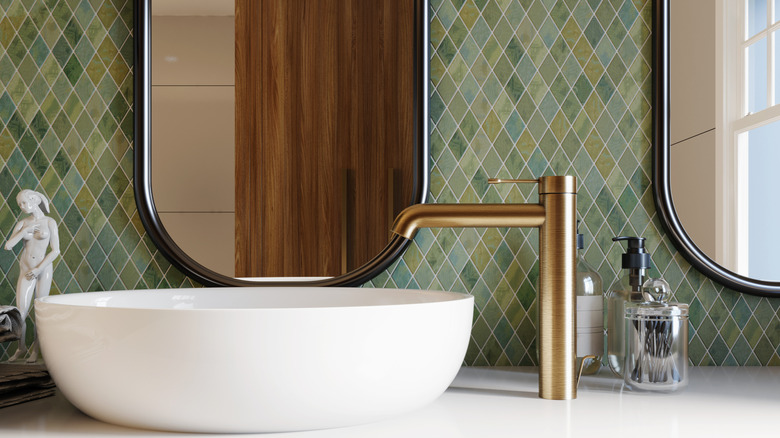This Classic Bathroom Design Trend Used To Be Huge - Now It's Dating Your Space
Rewind 10 or 15 years, and everyone remodeling a bathroom was after the spa-like aesthetic of all-white bathrooms. The monochromatic palette was valued for looking clean, crisp, and airy. Most bathrooms featured in magazines or on social media during the past couple decades boasted this light and bright colorless vibe.
However, just like all-white kitchens have become outdated, the same is true for bathrooms. This aesthetic has now faded from fashion, causing your once-trendy space to scream, "I was remodeled in the 2000s or 2010s!" Especially if you have white subway tile.
Why did the all-white look become so quickly outdated? As a professional interior designer, my short answer is that too many people did it poorly, cheaply, and in an excruciatingly boring way. My long answer is that because these one-note spaces typically lacked personality, they became the safe go-to for cheap house flips and bland, builder-grade new homes, leaving the industry wildly oversaturated with uninspired white-on-white-on-white bathrooms. You won't remember a stark, drab space with no personality, so homeowners started gravitating toward more exciting design choices to help their spaces feel more charming and memorable.
Don't fret if your home has one of these very bathrooms, however. White is one of the most versatile neutrals, and it really does exude a light and airy vibe. Even if you don't have the budget to fully renovate, there are some simple tricks, materials, and colors you can use to bring a soulless whitewashed bathroom to life.
Natural, organic materials will take your white bathroom out of the 2010s
Today's bathrooms are all about creating a cozy, inviting, and exciting bathroom space that pushes back against all of the sterile, uneventful white bathrooms of yesterday. Therefore, one of the main areas of focus is to warm up the finishes and colors throughout the space to give it more of a welcoming rather than stark vibe. This means that instead of the cool neutrals that were so popular in the 2000s and 2010s (gray and white), bathrooms are now boasting warmer color palettes and a wide range of organic textures and materials that connect it to nature.
So if you are refreshing an existing all-white bathroom, I recommend that you inject natural materials with a variety of exciting textures, to evoke a down-to-earth feeling with a dynamic and visually interesting aesthetic. Use organic brown tones — natural, reclaimed, bamboo, or teak wood — to bring in a sense of nature, whether that is done via planking on the wall, as a cabinet finish, for a vanity mirror frame, or even just a freestanding bathroom stool. Add natural stone material such as marble (with dark or warm veining), limestone, slate, onyx, or river rock to the space to continue the earthy yet high-end vibe, in places such as in the vanity countertop, sinks, shower tile or slabs, or even as an accent on your bathroom accessories. Handmade materials will also give a humble artisan aesthetic to the space, gloriously imperfect and full of texture, such as with hand-crafted Zellige tiles, a carved wood vanity, and hand-sculpted sinks, bathroom accessories, or light fixtures. Finally, add in natural greenery (real or artificial) to make these earthy materials spring to life.
Elevate your all-white bathroom with new colors and textures
When it comes to creating an inviting and upscale neutral color palette, warm color tones are the key to adding dimension as well avoiding the bland and uninspired white-on-white palette. You are certainly welcome to use white finishes, but warm them up with warm earthy colors like soothing beige or taupe and any of the wide spectrum of desaturated browns (from light to deep and moody).
For those open to giving their bathroom some serious personality, try injecting bolder colors like saturated earth tones, such as deep or rich blues, greens, pinks, and mustards, or moody jewel tones like dark emerald, amethyst, or sapphire. Tile is an amazing place to showcase some stunning color, but if you are not renovating, wall or cabinet paint, textiles, and artwork are wonderful places to start bringing a breath of fresh air to an all-white space. Finally, create a design-forward contrast by incorporating elements with a variety of textures, such as rough stone, smooth matte plaster, rustic wood, metallic brass, woven materials, and lush textiles. The combination of these elements creates a dynamic and exciting interior palette, whether neutral or colorful. In addition, choose bold patterns for tile, wallpaper, or textiles to add unique personality and wow factor.
By upgrading your existing space or upcoming bathroom design with warm finishes, natural materials, a variety of interesting textures, and some bolder color or pattern choices, you will create a design with a strong point of view that is both impactful and memorable, rather than the stark, forgettable all-white bathrooms of the past.


